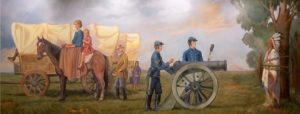The hilariously honest depictions of Indians in NBC’s Parks and Recreation

By Keith Corbiere
In April of 2009, a show began to air on NBC called Parks and Recreation, also commonly referred to as “Parks and Rec”. From the developer of the American incarnation of The Office, Parks and Rec followed the exploits of mid-level government workers employed in the Parks Department for the small, fictional, American town of Pawnee, Indiana.
In addition to mastering scathing political commentary on topics such as feminism, bureaucracy, and government, Parks and Rec also managed to paint a vivid and equitable picture of America’s relationship with the Indigenous people, on both a historic and modern level. For this reason and many others, it is one of my favourite shows to have graced television in the late 2000s.
Depictions of Indigenous people in modern media have been notoriously bromidic. The first portrayal I remember seeing on TV was in a 2003 episode of The Simpsons: Season 14, Episode 21, “Bart of War.” In the episode, Bart becomes a member of an Indigenous-themed peer group called the “Pre-Teen Braves.” Clad in deerskin vests and feathered headbands (with Homer even donning a traditional war bonnet), the group ventures out on a nature walk that has them encounter a Mohican Indian. The Mohican points out a field overrun with trash and litter, beseeching them to clean it. Even as a nine-year-old, I thought this episode was corny. In Episode 6 of Season 12 of Family Guy, “Life of Brian” (originally airing in 2013), Stewie and Brian visit an alternate reality in which Indigenous warriors were given guns at Jamestown, thus becoming the dominant race over Europeans in modern America. Although the premise was interesting, it quickly devolved into a one-note punchline about Indigenous people liking jean jackets. In both instances, I found myself disappointed in portrayals seemingly rife with potential.
Enter: Parks and Recreation. My favourite recurring joke of the series is the inclusion of disturbingly caustic murals portraying the relationship of early Pawnee settlers and early “Wamapoke” Indians, displayed on the walls of Pawnee City Hall. In Episode 3 of Season 1, “The Reporter”, main character and Parks Department Deputy Director, Leslie Knope (played by Amy Poehler), gives a local reporter a tour of their government building. Included in the tour is a viewing of one of City Hall’s murals, entitled, The Trial of Chief Wamapo. The mural depicts an Indian Chief tied to a tree, with two cavalry soldiers aiming a cannon at him from a few feet away. The description of the mural is as follows:
“Painted in 1936, this mural depicts the trial of Chief Wamapo, who was accused of ‘being Indian.’ Tragically, in 1834, that was a crime punishable by death. Despite the proximity of the cannon to Wamapo’s body, the cavalry missed him on their first two shots. On the third shot, they got lucky and hit his left shin. He died several years later of old age.”
Similarly hilarious is the mural Turnbill Mansion Wedding (portrayed in Season 2, Episode 21, “94 Meetings”), depicting a wedding ceremony between a Caucasian woman and an Indigenous Chief. The description reads:
“In 1867, the progressive Reverend Turnbill officiated a wedding between a white woman and a Wamapoke Indian Chief. The secret ceremony was beautiful and romantic. But then word got out and the reception was a bloodbath. Fortunately, there were two survivors. Unfortunately, they were both horses.”
The biting content of the murals is what initially got me hooked on the series. In addition to the murals, another gleaming example of good Indian representation came in the character of Ken Hotate (played by Comanche and White Mountain Apache actor Jonathan Joss, famously known for voicing John Redcorn on King of the Hill), the tribal elder and chief of the Wamapoke Tribe. A respectable and formal Indigenous man wearing a handsome suit, a bolo tie, and a ponytail, Hotate commands attention whenever on-screen. Debuting in Season 3, Episode 7, “Harvest Festival”, the plot sees Hotate imploring Leslie and the Parks Department to move the location of their Harvest Festival, as it will take place on the grounds of a Wamapoke massacre. When the Parks Department refuses, Hotate devilishly states that he hopes his ancestors “won’t put a curse on the festival”. The phony “curse” being placed is later re-enacted via computer animation on the local news, in one of the funniest scenes of the series. The appeal of the bits featuring Hotate is that he and his culture are never made the butt of the joke, with the laughs coming at the expense of the hapless and gullible Parks employees instead. Hotate continues to return to the series as a refreshing and venerable depiction of what Indigenous representation should look like in modern television.
Parks and Recreation aired from April 2009 to February 2015, for a total of 7 seasons and 125 episodes. Recommending the series to my friends and family comes not only by its treatment of Indigenous figures, but also its accessibility, sharp wit, talented cast and interesting characters, as well as its re-watchability. The series is finished airing now, but you can still watch it in Canada on Amazon Prime. So make sure to visit the town and residents of Pawnee, Indiana, for an Indigenous-positive, unforgettable piece of television.


